Scottish Health Survey 2016 - volume 1: main report
Statistics relating to the health of people living in Scotland.
10 Respiratory Health
Keeva Rooney
Summary
- In 2016, 4% of adults reported having Chronic Obstructive Pulmonary Disease (COPD), continuing the stable level since 2008.
- Reported COPD was associated with area deprivation; 2% of adults in the two least deprived quintiles, compared with 7% of those in the most deprived areas.
- At 10% in 2016, the proportion of all children, aged 0-15 years, that had reported doctor-diagnosed asthma has remained unchanged from 2015, reinforcing the observation of reduced levels since 2003 (16%).

- The prevalence of having wheezed in the last 12 months was higher among older adult age groups (17-18% for those aged 45 and over compared to 11-13% for those aged 16-44).
- The prevalence of ever wheezing was also linked to deprivation, with prevalence higher in the most deprived areas (36%) than the least deprived areas (25%).
- The prevalence of COPD varied with smoking status, from 1% of those who never or occasionally smoked, to 8% of those who smoked 20 cigarettes or more per day.
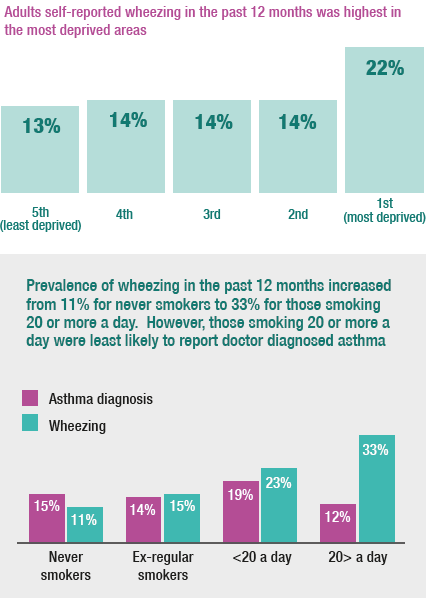
10.1 Introduction
Long-term respiratory conditions, such as asthma and chronic obstructive pulmonary disease (COPD) affect the flow of air in and out of the lungs. Both of these conditions are currently incurable and thought to be widely underdiagnosed[1,2]. As such, they represent a significant challenge for the individuals that live with them and for health services in Scotland.
The UK has one of the world’s highest rates of asthma[3], an illness characterised by variable and recurring symptoms of breathlessness, wheezing, coughing and chest tightness. Based on Quality Outcomes Framework data for 2011- 2012 financial year, it is estimated that around 320,000 people in Scotland are presently receiving treatment for asthma[4], a fifth of whom are children[5].
The reasons for the high prevalence of asthma in the UK are not clear, with the existence of the condition being associated with genetic factors, as well as environmental pollutants, including maternal smoking during pregnancy[6]. Factors associated with the onset of asthma attacks are wide ranging and include exposure to house dust mites, pollen, animals, specific foods, viral infections, moulds, fungi, environmental tobacco smoke[7], and air pollution[8]. Occupational exposures account for a substantial proportion of adult asthma incidence[9]. In many cases, asthma does not significantly affect quality of life when it is properly controlled[10]. Inhalers prescribed for respiratory conditions such as asthma had the highest total prescribed drug cost in the community (£35.5 million) in Scotland for 2015/2016[11]. The economic burden of asthma on the NHS in Scotland is estimated to be around £97.5 million a year, most of which is accounted for by prescription costs[4].
Estimates suggest that treating COPD costs the NHS in Scotland around £159 million a year and this will rise to £207 million a year by 2030[12]. COPD, which is less common than asthma, is a chronic and irreversible lung condition caused by restricted airways resulting in breathing difficulties, persistent coughing and abnormal sputum production[13]. The breathing restrictions associated with COPD are a major cause of repeated hospital admissions in Scotland[14].
Like asthma, the risk of COPD is increased by exposure to environmental pollutants and smoking. However, the role played by smoking is far greater in the case of COPD than in asthma. While asthma often appears in childhood or adolescence, COPD onset occurs in middle to late adulthood (though early life experiences, including childhood asthma, can increase its risk)[15,16,17]. The associations of long term conditions like COPD with deprivation, lifestyle risk factors and wider social health determinants are of importance in Scotland given the country’s persistent health inequalities[11].
10.1.1 Policy background
There has been increasing generic policy attention given to long-term conditions in Scotland, which tends to focus on community support and self-management[18]. However, there is some policy aimed specifically at respiratory conditions.
One of the Scottish Government’s National Performance Framework National Outcomes is for people in Scotland to ‘live longer, healthier lives’[19]. There is also a National Performance Indicator to ‘reduce premature mortality’ (deaths from all causes in those aged under 75)[20].
COPD is a major cause of death in Scotland, hence COPD prevention and better symptom management contributes to reducing premature mortality[21]. In addition, a number of the National Indicators[22] and many of the major public health initiatives that have been introduced in recent years are linked to key respiratory disease risk factors, most notably smoking[23], but also physical activity[24] and obesity[25].
Both asthma and COPD were included in the Quality and Outcomes Framework (QOF) used to measure general practice performance, though only COPD had an associated outcome measure (introduced in 2013/2014 relating to the measurement of oxygen saturation values)[26]. Due to the recent decommissioning of QOF in Scotland, its data is no longer publicly reported or used to inform payments to GP practices. The QOF data may continue to be extracted to support the peer led GP Cluster Continuous Quality Improvement process as part of the latest General Medical Services Contract.
Healthcare Improvement Scotland produced clinical standards for COPD in 2010[27]. A number of clinical guidelines have been produced for respiratory conditions including the Scottish Intercollegiate Guidelines Network guideline on the management of asthma ((SIGN) Guideline 153 - published September 2016[28] .
In 2016, the Smoking Prohibition (Children in Motor Vehicles) (Scotland) Bill was introduced, making it illegal from the 5th December 2016 to smoke in a car or vehicle whilst carrying those aged under 18 – an offence that could carry a £100 fixed penalty.
The Scottish Government is currently working with the Respiratory National Advisory Group to develop a quality improvement plan for Scotland, which is anticipated to be completed in 2017.
10.1.2 Reporting on respiratory conditions and symptoms in the Scottish Health Survey (SHeS)
The Scottish Health Survey (SHeS) is a valuable source of information on the self-reported prevalence of asthma and COPD in Scotland. It collects information about respiratory symptoms such as phlegm production, wheezing and breathlessness, symptoms often experienced by people without a diagnosed respiratory condition. It also provides valuable information on the patterning of these conditions and symptoms across different population groups.
This chapter presents data on adults’ self-reported doctor-diagnosed asthma, COPD prevalence, and respiratory symptoms (wheezing). Children’s asthma diagnoses and wheezing symptoms are also reported. Information on whether people with COPD receive treatment and the treatment type is also reported.
Area deprivation data for respiratory health are presented using Scottish index of Multiple Deprivation (SIMD) quintiles. To ensure that the comparisons presented are not confounded by the different age profiles of the quintiles, the data have been age-standardised. Readers should refer to the Glossary at the end of this Volume for a detailed description of SIMD and age-standardisation.
Supplementary tables providing further breakdowns are available on the Scottish Government SHeS website[29].
10.2 Methods
10.2.1 Asthma and COPD diagnoses
Participants (including parents of children aged 0-12, and children themselves aged 13-15) were asked if a doctor had ever told them they had asthma. This question was asked in the 1998, 2003, 2008 and 2010 surveys, and has been included every year since 2012. Each year since 2008, adult participants have also been asked if they had ever had COPD, chronic bronchitis or emphysema, and if so, whether a doctor had told them they had one of these conditions. Those who reported doctor-diagnosed COPD were also asked what treatment or advice they had received. No objective measures were used to confirm these reported diagnoses.
10.2.2 Respiratory symptoms
Questions on respiratory symptoms were included in the 1995-2003 surveys, and in all even years since 2008. The symptoms covered were: phlegm production, breathlessness and wheezing or whistling in the chest. Breathlessness was classified as grade 2 if it occurred when hurrying on level ground or walking up a slight hill, or grade 3 (the more severe form) if it occurred when walking with other people of the same age on level ground. The impact of such symptoms on sleep and people’s daily activities was also measured. The Medical Research Council Respiratory Symptom Questionnaire was used to collect some of this information[30].
10.2.3 Treatment for COPD
Questions on whether people are currently receiving any treatment or advice for COPD, chronic bronchitis or emphysema and if so, what type of treatment were introduced in SHeS in 2008.
10.3 Self-Reported Doctor-Diagnosed Asthma And Self-Reported Wheezing
This section looks at the self-reported lifetime prevalence of doctor-diagnosed asthma, wheezing or whistling in the chest in the last 12 months (referred to in the text as wheezing in the last 12 months), and lifetime wheezing. Trend data are presented for all adults aged 16 and over and for all children, aged 0-15, from 2003. As these questions were only asked of sub-samples in 2008 and 2010, data for those years have been combined.
10.3.1 Trends in self-reported doctor-diagnosed asthma and wheezing prevalence in adults since 2003
The percentage of people with doctor-diagnosed asthma in 2016 (15%) has not changed significantly from 2015 (17%). The proportion has fluctuated between 13% and 17% since the start of the time series in 2003.
The prevalence of wheezing in the last 12 months has dropped significantly to 15% in 2016, having previously been stable at 18% since 2012.
In 2016, 28% of adults reported having ever wheezed, a decrease from 2015 (30%) with the rate having been relatively stable since 2012 (between 30% and 31%).
Prevalence across the three measures (doctor-diagnosed asthma, ever having wheezed, and wheezing in the last 12 months) were similar for both men and women.
Figure 10A, Table 10.1
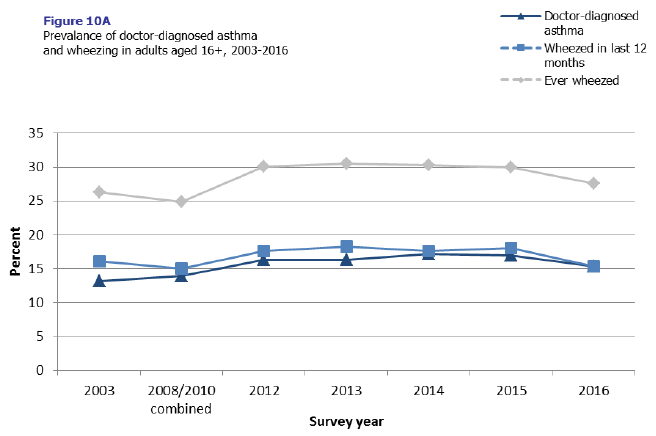
10.3.2 Trends in self-reported doctor-diagnosed asthma and wheezing prevalence in children since 2003
At 10% in 2016, the proportion of all children (aged 0-15) that have reported doctor-diagnosed asthma has remained unchanged from 2015, confirming the pattern of reduced prevalence since the start of the time series in 2003 (16%).
The prevalence of wheezing in the last 12 months for children was 13% in 2016; this has remained relatively constant since 2003 ranging between 12-14%. Similarly, rates of having ever wheezed remained relatively steady at 23%, having fluctuated between 21% and 25% since 2003.
In 2016 prevalence of doctor-diagnosed asthma was similar for boys and girls (10% and 9% respectively). Prevalence of having wheezed within the last 12 months was also similar for boys and girls (15% and 12% respectively). Boys were more likely to have ever wheezed than girls (26% and 19% respectively).
Prevalence of doctor diagnosed asthma fell for boys between 2003 (20%) and 2016 (10%) to a similar level to that for girls. Prevalence for girls fluctuated between 9% and 12% over the same period; 9% in 2016. Prevalence of wheezing in the previous 12 months was similar for boys and girls (15% and 12% respectively), with little change among girls since 2003 (11-12%) and some fluctuation for boys since 2003 (13-17%). Prevalence of ever having wheezed has shown little change over time with higher levels for boys (24-29%; 26% in 2016) than girls (19-22%; 19% in 2016).
10.3.3 Self-reported doctor-diagnosed asthma and wheezing prevalence in adults in 2016, by age and sex
As in previous years, prevalence of doctor-diagnosed asthma decreased with age in 2016, from 19% for 16-25 year olds, to 9% for adults aged 75 and older. Similar patterns were found for men and women.
Figures for having wheezed in the last 12 months also differed significantly by age. Adults aged 45 and over were more likely to report wheezing in the last 12 months (17-18%), than younger adults (11-13%).
There was no clear pattern across age groups for prevalence of those who had ever wheezed.
Figure 10B, Table 10.2
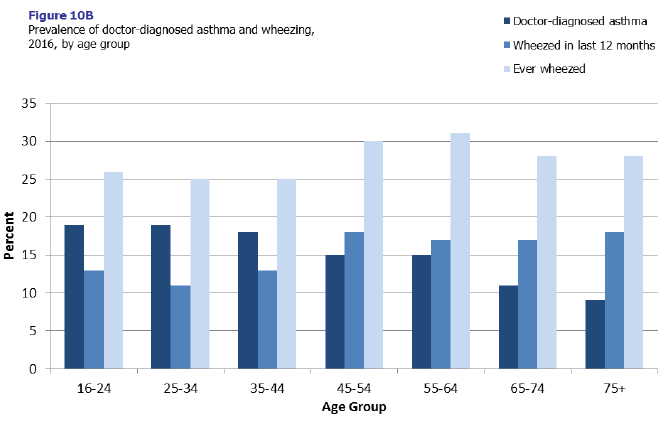
10.3.4 Self-reported doctor-diagnosed asthma and wheezing prevalence in 2016, by area deprivation (age-standardised)
Adults in the most deprived areas were significantly more likely to have doctor-diagnosed asthma than those in the least deprived areas (18% compared with 13%). A similar significant pattern was observed for women, however no significant association was found for men.
The proportion of adults who reported wheezing in the last 12 months increased significantly by deprivation status. In the most deprived areas 22% of adults (22% of men and 21% of women) reported wheezing in the last 12 months, compared to 13% of adults (15% of men and 11% of women) in the least deprived areas.
The prevalence of reporting ever having wheezed was also significantly associated with deprivation. The percentage of adults reporting ever having wheezed was 25% for those living in the least deprived areas and 36% for those living in the most deprived areas. Patterns were similar for men and women.
10.3.5 Self-reported doctor-diagnosed asthma and wheezing prevalence in 2016, by smoking status (age-standardised)
The prevalence of those who had ever wheezed or had wheezed in the last 12 months increased with smoking status. Prevalence of ever having wheezed ranged from 22% for those who had never smoked / smoked occasionally to 45% among those who smoked 20 or more cigarettes a day. Prevalence of wheezing in the last 12 months was 11% for those who had never smoked/smoked occasionally, rising to 33% for those who smoked 20 or more a day. In both cases prevalence did not significantly differ between men and women.
There were no statistically significant differences between the prevalence of asthma for different smoking statuses. Asthma prevalence peaked among those who smoked fewer than 20 cigarettes a day (19%) whilst those who smoked 20 or more a day had the lowest prevalence of doctor-diagnosed asthma at 12%. Non-smokers / those who smoked occasionally and those who used to smoke had similar asthma prevalence rates (15% and 14% respectively). The pattern of asthma prevalence and smoking status was similar for men and women. Although there was an apparent difference in asthma prevalence between men and women who smoked 20 or more cigarettes a day (9% men compared to 17% of women), this difference was not significant.
10.4 Doctor-Diagnosed COPD
This section looks at the self-reported prevalence of doctor-diagnosed (COPD), in adults aged 16 and over.
10.4.1 Trends in COPD prevalence in adults since 2008
The prevalence of doctor-diagnosed COPD in adults was 4% in 2016, continuing the stable trend since 2008 of 4% for every year with the exceptions of 2009 (3%) and 2010 (5%).
Rates of prevalence of doctor-diagnosed COPD were similar for men and women throughout this period.
10.4.2 COPD prevalence in 2016, by age and sex
A total of 4% of all adults reported having doctor-diagnosed COPD, with prevalence being highest in the older age-groups (9-11% for those aged 65 and over compared to 0-1% for those aged 16-44). Similar patterns were found for both men and women.
10.4.3 COPD prevalence in 2016, by area deprivation
As in previous years, doctor-diagnosed COPD was significantly associated with area deprivation, with the lowest prevalence (2%) found among adults in the two least deprived quintiles, and the highest prevalence (7%) in the most deprived.
This pattern was broadly similar for men and women, although men in the most deprived quintile reported a lower proportion of COPD than women (6% and 9%, respectively).
10.4.4 COPD prevalence in 2016, by smoking status
Prevalence of doctor-diagnosed COPD was lower for those who were ex-smokers (5%) than those smoking 20 or less a day (8%) and those smoking 20 or more a day (8%). The lowest prevalence was reported in adults who never / or only occasionally smoked (1%).
A similar pattern was found for women. However, for men, although there was significantly lower prevalence of COPD amongst those who never / or only occasionally smoked (1%) there were no significant differences in COPD prevalence between the remaining smoking statuses (see Figure 10C).
Figure 10C, Table 10.8
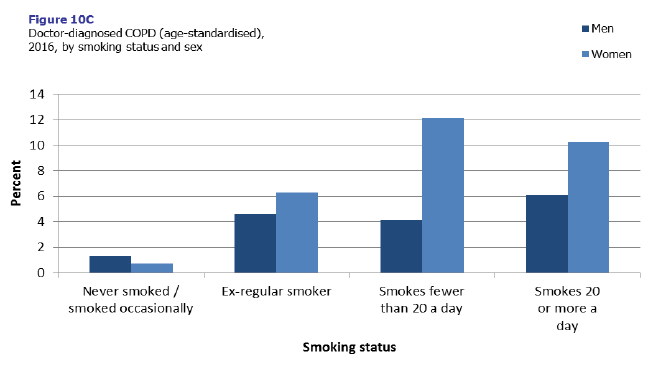
10.4.5 COPD treatment and advice in 2013-2016 combined
Of all adults with doctor-diagnosed COPD, 73% were receiving treatment (71% of men and 75% of women). Treatment varied with age, with those aged 65 and over more likely to be receiving treatment (80%) than those aged 16-64 (66%). Prevalence of those receiving treatment for COPD was the same for both men and women aged 65 and over (80%). There was no statistically significant difference in prevalence of those receiving treatment between men and women (71% and 75% respectively).
Taking medication (tablets / inhalers)
Taking medication such as tablets or inhalers was the most common form of treatment (68%) with similar findings for men and women. Adults aged 65 and over were more likely to report this as a treatment than those aged 16-64 (74% compared with 61%).
Regular check-up with GP / hospital / clinic
Of adults who were diagnosed with COPD, 61% had regular check-ups with medical professionals as a treatment for COPD. This was the second most common treatment at 68% for those aged 65 and over and 53% for those aged 16-64. Figures were similar for men and women.
Immunisations against influenza/pneumococcus
Immunisation against flu and / or pneumococcus was the third most common treatment for COPD, reported by 35% of adults. This treatment was more prevalent in men aged 65 and over at 43% than for men aged 16-64 (25%), whilst rates for women were similar for the two age groups (36% for those aged 16-64 and 32% for those 65 and over).
Advice or treatment to stop smoking
Of adults diagnosed with COPD, 22% reported that they had advice or treatment to stop smoking in order to treat COPD, with no difference between men and women. However, this differed significantly by age, with 26% of adults aged 16-64 years and 18% of those aged 65 and over reporting having received advice or treatment to stop smoking. This treatment was more prevalent among men aged 16-64 (32% compared to 14% of men aged 65 and over). The prevalence of women who reported this treatment was the same for both age groups (22%).
Exercise or physical activity
Exercise accounted for 10% of reported COPD treatment (9% of adults aged 16-64 and 10% of adults aged 65 and over). Men were more likely to use exercise or physical activity as a treatment for COPD compared to women (14% and 6%, respectively). Men aged 65 and over reported the highest use of this treatment (16% compared to 13% of men aged 16-64). Rates were similar for women of both age groups (6-7%).
Advice / treatment to lose weight
Advice or treatment to lose weight was reported by 6% of adults as a treatment for their COPD with no significant difference by age. There were no significant differences between men and women.
Using oxygen
Using oxygen was the least common treatment for COPD (4%). Prevalence of this treatment was the same for both the 16-64 and 65 and over age groups (5% for women and 3% for men).
Figure 10D, Table 10.9
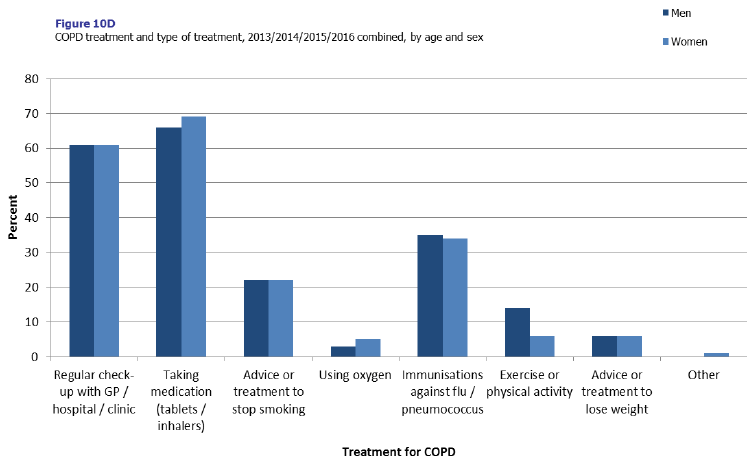
Contact
Email: Julie Landsberg, Julie Landsberg
Phone: 0300 244 4000 – Central Enquiry Unit
The Scottish Government
St Andrew's House
Regent Road
Edinburgh
EH1 3DG
There is a problem
Thanks for your feedback
